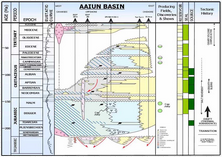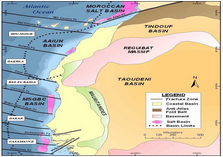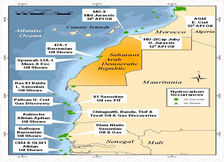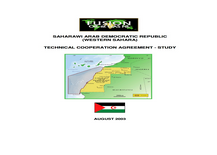Petroleum
Geological Summary
Regional Geology
The Aaaiun Basin, is one of a series of mature passive margin basins that lie along to North Atlantic margin of Northwest Africa and the northeast margin of North America. The basin extends for almost 1,100km from the Cap Blanc Fracture Zone in northern Mauritania, north through Western Sahara into southern Morocco to the intersection of the North Canary Island Fracture Zone.
The Aaiun Basin comprises two discrete sub-basins separated by the Dakhla Fracture Zone. The northern Boujdour sub-basin is largely characterised by an absence of Senonian aged sediments in the slope region, the result of major Early Tertiary canyon incision and the erosive effects of contour currents that developed across the slope and upper rise. Onshore the sub-basin is characterised by over 3km of Early Cretaceous deltaic sediments. Conversely the southern Dakhla sub-basin is characterised by the presence of a thick (up to 1km) Senonian sand-rich succession in the deepwater portion and the absence of Cenomanian-Paleocene sediments onshore.
Petroleum Geology
 Although the quantity and quality of geoscience information is limited it is probable that all the key elements (reservoir, source, seal and trap) critical to exploration success are likely both present and effective within certain areas. Early Cretaceous-Late Tertiary delta systems have been instrumental in establishing the presence and controlling the effectiveness of the various elements of the petroleum systems.
Although the quantity and quality of geoscience information is limited it is probable that all the key elements (reservoir, source, seal and trap) critical to exploration success are likely both present and effective within certain areas. Early Cretaceous-Late Tertiary delta systems have been instrumental in establishing the presence and controlling the effectiveness of the various elements of the petroleum systems.
Two distinct petroleum systems identified in the offshore area are considered to have excellent potential for the discovery and commercial development of hydrocarbons:
The continental slope region south of the Dakhla Fracture Zone (i.e. the Dakhla sub-basin) contains two potentially oil prone source rocks, multiple reservoir intervals and both structural and stratigraphic trap types. Within the slope region the primary Aptian-Albian source interval is interpreted to be present and mature, with additional potential at the Cenomanian-Turonian level. Maturity of these intervals is driven by the thick Senonian and Tertiary wedges, which along with the Neocomian-Barremian section provide multiple stacked reservoirs. In the northern portion of the Dakhla sub-basin, the southern extensions of the “Slope Anticline” and arcuate fault zone have been mapped, and provide relatively low risk structural trapping mechanisms. In addition to the structural traps significant potential exists in stratigraphic traps in the form of perched canyon fill, onlap wedges and submarine fans.
The outer continental slope region north of the Dakhla Fracture Zone (i.e. the Boujdour sub-basin) is reliant on an appreciably different petroleum system to that in the Dakhla sub-basin, however significant potential is considered to exist, with a potential source rock, a thick reservoir section and large structural features all likely to be present. The Jurassic interval is a proven source interval in areas to the north including Morocco and Portugal, provides excellent quality source facies, which is potentially oil-mature in the outer slope. The thick Neocomian-Barremian delta complexes provide stacked reservoir potential, also drive the maturity of the underlying Jurassic source interval. The large “Slope Anticline” and the extensive arcuate fault zone provide multiple relatively low-risk structural trapping mechanisms, while additional higher risk traps, including onlap wedges and submarine fans, are also expected to exist.
Prospectivity
While the deepwater portions of offshore SADR remain virtually unexplored and are untested by the drill-bit, recent increases in activity and significant discoveries in the contiguous northern MSGBC Basin, including the deepwater oil discoveries at Chinguetti, Tiof and Tevet and gas discoveries at Banda and Pelican in Mauritania, highlight the potential for deepwater oil discoveries in the Aaiun Basin.
Similarly, the onshore portion of the Aaiun Basin has been largely neglected over the past 35years, however, analogous areas (onshore Mauritania and Morocco) are now receiving increasing levels of interest, which is testament to the potential which exists in these lightly explored regions.
Further Information
Interested parties are invited to purchase the Regional Report on the SADR, originally compiled by Fusion Oil and Gas.
For more information please contact us.



